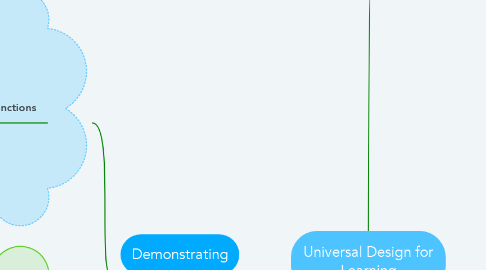
1. Demonstrating
1.1. Executive Functions
1.1.1. Brain functions which controls initiation, flexibility, attention, organization, planning, working memory, self-awareness and emotional regulation
1.1.1.1. Scaffold learning
1.1.1.1.1. frameworks
1.1.1.1.2. exemplars
1.1.1.1.3. rubrics
1.1.1.2. methods and modelling
1.1.1.2.1. Visual and verbal vocalization of thinking
1.2. Expression & Communication
1.2.1. Provide students with options to communicate and express ideas
1.2.2. Use technology to support expression and communication
1.3. Physical Actions
1.3.1. Goal is for students to use technology independently
1.3.1.1. Be aware of physical challenges and accessibility
1.3.1.1.1. optimize access to technology
1.3.1.1.2. vary methods
2. Engagement
2.1. Self-Regulation & Metacognitive Learners
2.1.1. Students understand how they learn, set goals, sustain effort, seek help and, recognize and cope with their emotions.
2.1.1.1. Educators can:
2.1.1.1.1. Promote positive expecations
2.1.1.1.2. Demonstrate coping stragties
2.1.1.1.3. Aid in self-assessment and reflection
2.2. Effort & Presistence
2.2.1. Highlight Goals and Vary Demands
2.2.1.1. Chunk learning, provide checkpoints and tasks
2.2.1.2. Help view failure as part of learning process and growth
2.2.1.3. Provide opportunity for collaborative learning
2.3. Recruiting Interest
2.3.1. Personalized Learning & Inquiry
2.3.1.1. Design and promote meaningful, relevant, interesting, and valuable learning
2.3.1.2. Lessons/ activities should intrigue students, though exploration, inquiry and flexible thinking
2.3.1.2.1. Learning is engaging and challenging at the student's level of ability
2.3.1.3. Students choose methods, means and delivery
3. Repersentation
3.1. Learning Comprehension Skills
3.1.1. Students learn to organize, understand and determine validity of information
3.1.1.1. Answer questions & solve problems (beyond regurgitation of information)
3.1.1.1.1. find innovative solutions
3.1.1.2. Activate background knowledge
3.1.1.3. Find key ideas
3.1.1.3.1. process, organize, visualize and comprehend information
3.2. Language, Mathematical Expression & Symbols
3.2.1. Provide variety of options to showcase learning
3.2.1.1. text
3.2.1.1.1. vocabulary
3.2.1.1.2. images
3.2.1.1.3. speech-to-text
3.2.1.2. diagrams
3.2.1.2.1. wordmaps
3.2.1.2.2. powerpoints
3.2.1.3. video & audio
3.2.1.3.1. movie maker
3.2.1.3.2. audio file
3.3. Perception
3.3.1. access to information
3.3.1.1. interactive materials and resources
3.3.1.1.1. audio
3.3.1.1.2. video
3.3.1.1.3. text

